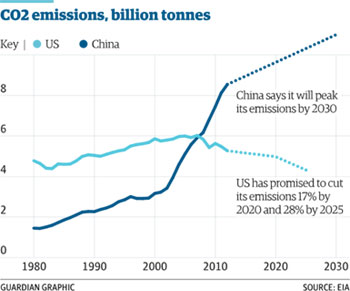by Rona Fried
Now that I’ve vented my anger about Democrats’ potential vote on the Keystone pipeline, let’s turn to the good news on climate change – President Obama’s announcement on an agreement with China.
News services are buzzing about the joint release issued from Beijing today, by President Obama and President Xi Jinping:
- Obama set a new target for cutting US emissions: 26-28% below 2005 levels by 2025, up from his current goal of 17% by 2020.
- China committed to peak its carbon emissions no later than 2030, and to achieving 20% clean energy through renewables and nuclear by then.
In 2013, China agreed to phase out climate forcing HFCs in another important agreement.

The US goal is both "ambitious and achievable, grounded in an intensive analysis of what actions can be taken under existing law, and will double the pace of carbon pollution reduction in the United States from 1.2% per year from 2005-2020, to 2.3-2.8% from 2020-2025, says John Podesta, Counselor to Obama. And it keeps us on track to cut emissions 80% by 2050, the amount necessary to keep global temperatures from rising more than 2 degrees Celsius, he says.
Unfortunately, meeting the US target hinges on the EPA regulations Republicans vow to block. Here’s Mitch McConnell’s reaction to the news: "Our economy can’t take the president’s ideological war on coal that will increase the squeeze on middle-class families and struggling miners. This unrealistic plan, that the president would dump on his successor, would ensure higher utility rates and far fewer jobs."
To reach its goal, China will have to deploy an additional 800-1000 gigawatts of zero-emission generation capacity by 2030 – equivalent to all its current coal-fired capacity.
These goals may seem hard-to-reach, but experts say the countries erred on the conservative side. China will reach 15% renewable energy by 2020, says Tao Wang, a climate scholar at Tsinghua-Carnegie Center for Global Policy in Beijing.
"It’s a new day to have the leaders of the US and China stand shoulder to shoulder and make significant commitments to curb their country’s emissions," says Andrew Steer, President of the World Resources Institute. The two countries are responsible for 40% of global emissions.

Credit: Nick Evershed/Guardian Australia
Stage Set for Climate Summit
Most importantly, the announcement sets the stage for next year’s Climate Summit in Paris – in fact, it’s viewed as the critical breakthrough necessary to finally hammer out an international climate treaty.
"This agreement removes the biggest stumbling block to a global climate accord, namely the unwillingness of the United States to act without a commitment from China (and visa-versa), and the unwillingness of other countries to act without strong commitments from both countries," notes Ken Kimmel, President of Union of Concerned Scientists.
The European Union recently finalized its new binding commitments: by 2030 – cut greenhouse gas emissions 40%below 1990 levels; achieve 27% renewable energy; increase energy efficiency by 30%. France committed to go beyond these targets to 32% renewable energy for electricity, heat and fuel, and to cut energy demand in half – all while reducing the role of nuclear. At September’s Climate Summit in NYC, countries from Chile to Ethiopia set ambitious climate targets.
The announcement says:
"The United States of America and the People’s Republic of China have a critical role to play in combating global climate change, one of the greatest threats facing humanity.
To this end, President Barack Obama and President Xi Jinping reaffirmed the importance of strengthening bilateral cooperation on climate change and will work together, and with other countries, to adopt a protocol, another legal instrument or an agreed outcome with legal force under the Convention applicable to all Parties at the United Nations Climate Conference in Paris in 2015. They are committed to reaching an ambitious 2015 agreement that reflects the principle of common but differentiated responsibilities and respective capabilities, in light of different national circumstances.
The United States intends to achieve an economy-wide target of reducing its emissions by 26%-28% below its 2005 level in 2025 and to make best efforts to reduce its emissions by 28%. China intends to achieve the peaking of CO2 emissions around 2030 and to make best efforts to peak early and intends to increase the share of non-fossil fuels in primary energy consumption to around 20% by 2030. Both sides intend to continue to work to increase ambition over time.
The United States and China hope that by announcing these targets now, they can inject momentum into the global climate negotiations and inspire other countries to join in coming forward with ambitious actions as soon as possible, preferably by the first quarter of 2015. The two Presidents resolved to work closely together over the next year to address major impediments to reaching a successful global climate agreement in Paris."
"There’s one issue that will define the contours of this century more dramatically than any other," says President Obama. "And that is the urgent and growing threat of a changing climate."
In addition to signaling "a historic shift away from dirty fossil fuels, it could drive a new global competition for clean energy technology," notes Michael Brune, Executive Director of Sierra Club.
Read the historic US-China Joint Announcement on Climate Change, which outlines areas that are cooperating on:

Obama get out that Exec. Order pen again. BTW make it 90% below 2005 levels. Thank you